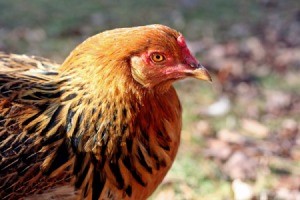 The Rhode Island Red is one of the most popular breeds among backyard hobbyists. Although they can also be raised and eaten for meat, these rust-feathered fowl have earned their popularity mostly due to their prolific egg laying ability, calm temperament, and their ability to adapt to nearly any environment.
The Rhode Island Red is one of the most popular breeds among backyard hobbyists. Although they can also be raised and eaten for meat, these rust-feathered fowl have earned their popularity mostly due to their prolific egg laying ability, calm temperament, and their ability to adapt to nearly any environment.
Rhode Island Reds were developed in Rhode Island and Massachusetts in the 1830s by poultry farmers looking for a meaty bird that also had excellent egg-laying abilities. One of the foundation sires of the breed was a black-breasted red Malay cock imported from England. (This cock is actually still kept on display at the Smithsonian Museum). It is from its Malay heritage that Rhode Island Reds get their deep color, hardy constitution, and relatively hard feathers. The breed was first admitted to the APA in 1904, and was held in such high esteem that it garnered the unusual honor of being named Rhode Islands state bird in 1954, the only breed in the APA Standard of Perfection to receive such an award.
Rhode Island Reds, along with the Sussex breed, have been used to develop many modern hybrid breeds due to their prolific egg-laying ability. Exported to countries around the world, the Rhode Island Red is one of the most widely distributed breeds of chicken on the planet.
The Rhode Island Red is a wonderful dual-purpose breed for the small flock owner. The hens are prolific egg layers, and although they are not considered meat specialists, their size and confirmation do make for good eating. Not only are they good free-range foragers, but they also tolerate confinement and have the ability to adapt to a less-than-ideal diet while continuing to produce eggs. The hens are reported to be calm and loving, although they are likely to be the more chatty and dominant chickens in your coop. Those that go broody, which seldom happens among the well-developed egg-laying strains, act as caring mothers to their chicks. Many of the Rhode Island Red males (not all) may be quite aggressive at times. Overall, Reds are hardy to extreme temperatures and considered a healthy, long-lived breed.
No matter which breed of chicken you choose for your backyard flock, each will have its own unique characteristics. If youre looking for a reliable all-around bird, one that marries outstanding egg production with a meaty frame, then the Rhode Island Red definitely deserves a spot near the top of your list.
Check out these photos.
Whitey and Lucky are 3 days old in this picture. They are Rhode Island Red Mix. Imagine the surprise of going to feed the chickens on January 2, 2010 when my grandson yells "babies."